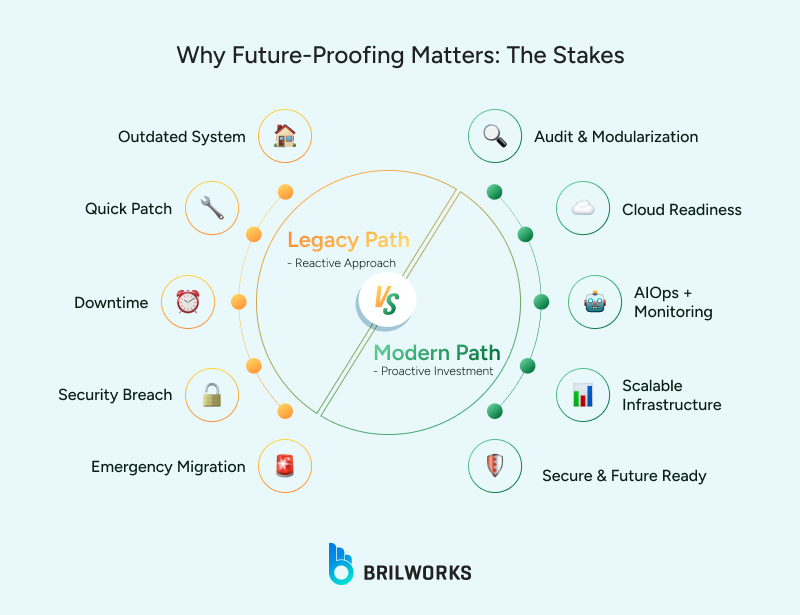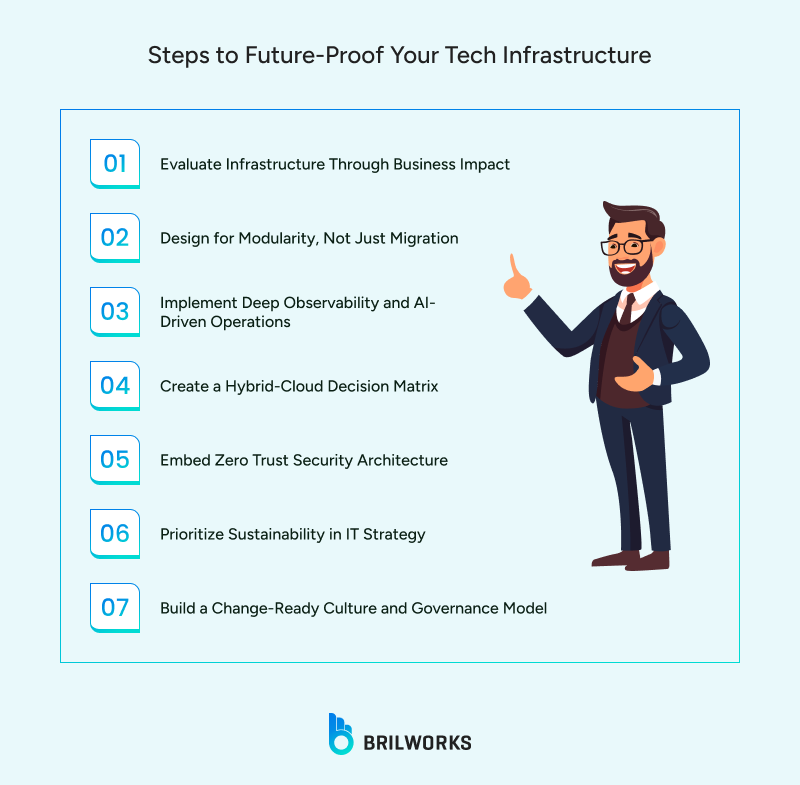COOPERATION MODEL
ARTIFICIAL INTELLIGENCE
PRODUCT ENGINEERING
DevOps & Cloud
LOW-CODE/NO-CODE DEVELOPMENT
INDUSTRY
FRONTEND DEVELOPMENT
CLOUD DEVELOPMENT
MOBILE APP DEVELOPMENT
LOW CODE/ NO CODE DEVELOPMENT
EMERGING TECHNOLOGIES







-1749022988394.webp)
By 2028, a substantial majority of enterprises will rely on AI-driven infrastructure, with global spending forecasted to surpass $200 billion. Artificial intelligence has brought about numerous waves that have shaken the IT world to its core. However, AI is just one of the emerging trends; there are other IT infrastructure trends on the horizon that need your attention if you want to stay ahead.
That is why future-proofing your IT infrastructure is important. But should you really need to future-proof? And if so, then how can you do it? Is your IT infrastructure prepared to address these trends? We will guide you through all these questions and provide you with practical steps that you can follow to safeguard your future.

The choices you make today will shape the future of your IT infrastructure, especially when nearly one-third of enterprise systems still rely on outdated technologies. Maintaining this outdated system can take up to 80% of your IT budget. Not only that, but they are also responsible for more than 35% of the power consumption in your organization. Which is why modernizing your legacy systems becomes all the more important.
Let’s illustrate this with a hypothetical example.
Imagine you are running a mid-sized logistics company that built its digital operations on a monolithic, on-premise system a decade ago. It worked well at the time, handling order processing manually, routing, and internal communication. But then, customer expectations changed. Your competitors started to offer real-time tracking, AI-optimized delivery routes, and seamless mobile apps.
Whether you're adopting cloud-native technologies or navigating multi-cloud complexity, having the right strategy and partner makes all the difference. We work with CIOs and tech leaders to build resilient, future-ready systems. Let’s connect and shape what’s next.
Your company, however, can't adapt quickly. Its infrastructure is rigid. You decide to integrate AI features and sync with third-party logistics partners. But turns out that requires months of custom development, which can halt your business for days or even weeks.
While you are in the process of upgrading, your competitor did not wait for you to finish and quickly snatched your market away from you. They even started to take it a step further, deploying new features in weeks through containerized, cloud-native systems.
As regulatory frameworks tighten around data privacy and sustainability, your company also finds itself struggling to comply. It lacks the observability and flexibility modern systems provide. Eventually, not only does your company lose market share, but it also faces growing operational costs and difficulty attracting skilled tech talent who don't want to work on outdated systems.
In contrast to your competitor, they invested early and they adopted. As new technologies emerged, your competitor was able to test, integrate, and deploy them rapidly, which gave them a consistent edge in performance, customer satisfaction, and innovation.
What your company should have done instead:
Adopted a modular architecture early
Moved toward a hybrid or cloud-native infrastructure
Prioritized API-first development
Embedded observability and monitoring tools
Invested in infrastructure automation
Future-focused tech strategy alignment
We will get to how you can future-proof and tackle IT infrastructure trends in the upcoming section.

Before we discuss how to future-proof your IT infrastructure, let's examine the key trends you need to consider for future-proofing. Every field has its own trends; mobile app development has its own trends, as does Fintech, and so on. Examining these trends can help you identify areas where you might be lacking. Because trends are the current hot topics and are likely to become the future norm. Here are six key IT infrastructure trends that need your attention:
The rise of AI is reshaping infrastructure from the inside out. AIops, meaning the use of artificial intelligence to enhance IT operations, is becoming a cornerstone of modern infrastructure strategy.
Remember our hypothetical scenario? One of the pain points in it was the lack of system observability. Without visibility into performance bottlenecks or early warnings for failures, teams can get stuck instead of proactively optimizing. AI infrastructure provides that observability that allows you to detect anomalies before they become outages, and automates root-cause analysis so teams spend less time firefighting and more time innovating.
Nowadays, you can see that there is a surge of IoT devices, especially in healthcare and fitness app development. Those IoT devices, such as fitness trackers, need to process lots of data to showcase accurate results.
Edge computing is a distributed computing model that processes, stores, and analyzes data closer to its source, which is why it is exceptionally helpful in IoT development. Edge computing reduces latency, improves performance, and allows for processing real-time insights faster.
The future of IT infrastructure is hybrid. A hybrid cloud combines on-premises (private) infrastructure with one or more public cloud services, integrating them to function as a single, coordinated environment that strikes a balance between control and scalability. Sensitive data and critical workloads can remain on private infrastructure, while less sensitive data can leverage the scalability and innovation of public clouds.
Furthermore, a multi-cloud environment involves using cloud services from multiple public cloud providers. This strategy can help you select the best cloud service for each specific workload or requirement. Also, you can avoid vendor lock-in and distribute workloads accordingly across providers to minimize downtime.
The fourth trend on our list of IT infrastructure trends is the adoption of zero-trust security. IT infrastructures contain the bulk of data, much of which is also sensitive and confidential. There is always a chance of attacks that could harm your business. That's why following best practices for security is important, but moreover, you need to adapt to new security frameworks as well.
Zero Trust security is a contemporary approach that assumes no user, device, or application is inherently trustworthy. Instead of granting blanket access, it enforces strict verification at every step—each access request must be authenticated, authorized, and validated continuously before access is permitted.
The sustainable infrastructure trend has gained significant traction in recent years. Its emphasis is on the design, construction, and operation of infrastructure that minimizes environmental impact, reduces resource consumption, and strengthens adaptability to climate-related challenges.
This approach is now central to the development of cities, buildings, and transport systems, aiming to create long-term economic, social, and ecological benefits.
The shift to cloud-native infrastructure, including containers, Kubernetes, and serverless computing, continues to accelerate. These technologies enable greater agility, portability, and scalability across environments. Cloud-native stacks are designed for change, making them ideal for companies aiming to innovate rapidly without compromising reliability or cost control.
Also read: Benefits of Cloud Migration Services

Based on IT infrastructure trends, we have laid out these steps that will help you address each trend specifically, because just knowing doesn’t make a difference; turning those insights into action does. Future-proofing your infrastructure means making intentional, strategic choices today that enable agility, resilience, and scalability tomorrow. Here's how IT leaders can get started:
A future-proof infrastructure starts with a deep, holistic understanding of what you have, not just technically, but in terms of business impact. Too often, audits focus only on hardware inventories or software or software versions, missing how infrastructure enables or limits key business capabilities.
How to approach this audit effectively:
Map systems to business functions such as revenue generation, compliance, and customer experience to understand their impact and prioritize modernization efforts.
Classify systems by criticality into core (mission-critical), supporting, and legacy or shadow systems that may be overlooked but still affect operations.
Identify single points of failure and dependencies that could cause outages or bottlenecks, including hidden legacy services supporting critical apps.
Evaluate scalability and flexibility of infrastructure components to determine if they can support future growth and rapid change.
Involve stakeholders from IT, security, compliance, finance, and product teams to get a comprehensive and accurate view of infrastructure strengths and weaknesses.
Develop a future-readiness scorecard to rate each system on scalability, integration ease, maintenance effort, and business impact, guiding prioritization objectively.
Without understanding the business outcomes your infrastructure supports, you risk misallocating budgets and efforts, upgrading non-critical systems while leaving vital ones exposed. This audit aligns your tech investments directly to what drives value and resilience.
Updating your infrastructure goes beyond simply migrating to the cloud or replacing outdated hardware. When designing for modularity, focus less on migration and more on how your systems are built so they can evolve quickly, scale efficiently, and integrate seamlessly.
Here’s how to achieve modularity:
Move beyond “lift and shift.” Simply migrating applications to the cloud without redesigning them often locks in legacy inefficiencies and inflates costs. Aim to re-architect critical systems for modularity.
Adopt microservices or domain-driven architectures. Break monolithic applications into smaller, loosely coupled components that can be updated or scaled independently.
Use containerization and orchestration. Technologies like Docker and Kubernetes enable portability, consistency, and automated scaling across environments.
Standardize integrations with API gateways. This promotes seamless communication between services and simplifies adding or replacing components without disruption.
Pilot modular designs on less critical services first. Demonstrate value and gather learnings before scaling the approach enterprise-wide.
Modular architectures reduce technical debt, speed up innovation cycles, and make your infrastructure adaptable to changing business needs and emerging technologies.
As your IT infrastructure grows more complex with distributed systems, hybrid clouds, and multiple services, traditional monitoring falls short. You need deep observability combined with AI-powered operations (AIops) to maintain resilience and agility.
Here’s how you can implement effectively:
Deploy comprehensive observability tools like Datadog, New Relic, or Splunk that collect metrics, logs, and traces across your entire infrastructure.
Integrate AIOps platforms to automate anomaly detection, correlate events, and predict incidents before they impact users.
Link infrastructure telemetry to business KPIs so alerts reflect actual business impact, not just technical thresholds.
Use AI-driven root cause analysis to reduce incident resolution times and free teams from alert fatigue.
Hold regular cross-team reviews of observability dashboards to align IT, security, and business units on infrastructure health and priorities.
Without deep observability and AI assistance, teams can miss critical issues or spend excessive time firefighting. AIOps helps move from reactive to proactive operations, improving uptime and accelerating innovation.
Now it's time to migrate to the cloud. As we saw in the IT infrastructure trends, a hybrid cloud environment can safeguard your data. Following this, a multi-cloud environment can help you reduce costs and boost efficiency. But when you choose multi cloud service providers, it's important to decide where to place workloads, as it can affect cost, performance, security, and compliance. A structured decision matrix can help avoid common pitfalls like cloud sprawl and costly inefficiencies.
Here's what you can do:
Define clear criteria for workload placement, such as compliance requirements, total cost of ownership (TCO), latency needs, and data gravity.
Classify workloads into categories like cloud-optimal, cloud-neutral, or cloud-averse based on their business and technical needs.
Assess regulatory and compliance requirements early on, such as GDPR or HIPAA, to prevent unexpected issues down the line.
Assess connectivity and latency requirements, especially for real-time or edge applications.
Revisit placement decisions periodically to consider cloud repatriation — sometimes moving workloads back on-premises or to private clouds reduces costs and improves control.
Document and communicate the decision matrix across teams to ensure consistent workload placement aligned with business goals.
A well-defined decision matrix prevents wasted spend and operational complexity, while ensuring workloads run where they deliver maximum value and meet all requirements.
Zero trust is a modern security framework, it's a fundamental shift in how you design and operate your infrastructure. Security needs to be baked into every layer, ensuring verification and least privilege everywhere.
Here’s how you can embed Zero Trust:
Implement identity-centric access controls that continuously verify users and devices before granting access, regardless of location.
Segment your network and workloads to minimize blast radius if a breach occurs, enforcing strict micro-segmentation policies.
Adopt continuous monitoring and adaptive authentication based on real-time risk assessment, not just static credentials.
Integrate Zero Trust principles into CI/CD pipelines and DevOps workflows to ensure security checks are automated and consistent.
Regularly audit and update your Zero Trust architecture as new threats emerge and business needs evolve.
Relying on perimeter defenses alone leaves your infrastructure vulnerable. Embedding Zero Trust into the very architecture limits lateral movement, reduces attack surfaces, and strengthens overall resilience.
Green IT strategy is important in our current climate change. Sustainability involves building infrastructure that's efficient, ethical, and future-ready. With rising energy costs, regulatory pressures, and ESG expectations, sustainable IT is becoming a core business driver.
Here's how you can align infrastructure with sustainability goals:
Measure your IT carbon footprint across data centers, cloud usage, and device lifecycle. Use tools like Cloud Carbon Footprint or providers’ native dashboards (e.g., AWS’s Customer Carbon Footprint Tool).
Optimize workloads for efficiency, scheduling non-critical tasks during off-peak hours and right-sizing cloud instances to avoid waste.
Choose cloud providers and data centers with strong renewable energy commitments, transparent sustainability reporting, and green certifications.
This way, future-proofing your infrastructure not only involves increasing your performance and scalability but also becomes environment-friendly by reducing waste and managing energy.
Even the most advanced infrastructure will fail to deliver long-term value without a culture that embraces change. Future-proofing requires more than tools; it needs mindset shifts, strong governance, and continuous alignment between business and tech.
Create cross-functional governance teams for each aspect, like IT, security, product, finance, compliance, etc, that not just oversee the process but align them with goals.
Invest in continuous upskilling, especially emerging trends like AI infrastructure, cloud-native development, etc. Encourage your team to utilize AI tools if they can increase productivity and workflow.
Future-proof infrastructure depends on people and processes as much as platforms. Without cultural buy-in and responsive governance, even well-planned modernization efforts stall or regress.
In 2019, Capital One, a digital banking leader, faced one of the most high-profile data breaches in financial services. A misconfigured firewall allowed an outsider to access sensitive data, compromising the Social Security numbers of roughly 1 million individuals in the U.S. and Canada. You can read the full details on their official 2019 breach report.
The breach was a wake-up call. But more importantly, it became a turning point.
Capital One doubled down on modernizing its infrastructure, rebuilding with security, agility, and resilience at the core.
Here's what changed:
Capital One had already begun migrating to AWS, but post-breach, their transformation accelerated. They become one of the first major banks to operate primarily in the public cloud, not just to cut costs, but to scale faster, deploy more securely, and automate infrastructure management. This flexibility becomes crucial for quickly identifying and responding to threats.
The incident exposed the weaknesses inherent in conventional security measures. Capital One transitioned to a Zero Trust architecture, eliminating implicit trust in their network. Every user and device, internal or external, now faces continuous, risk-based authentication, minimizing lateral movement and reducing attack surface.
Capital One didn't just rely on people to plug gaps. They embedded machine learning across security operations, enhancing fraud detection, automating threat recognition, and optimizing response times. But it didn't stop at defense. AI now powers personalized customer experiences, real-time support, and intelligent decisioning.
Capital One turned a moment of vulnerability into a long-term strength. Today, they are not just known for their recovery. They are recognized as a leader in cloud-first banking, AI-driven customer intelligence, and modern cybersecurity architecture.
Lesson for Tech Leaders:
If you take one thing out of this blog and this incident, then let it be this. No infrastructure is breach-proof. But how you respond, and whether you treat modernization as a checkbox or a strategic imperative, can define your resilience and reputation for years to come.
Tech infrastructure used to be a back-office concern. Today, it's a frontline differentiator. From the agility needed to pivot with market shifts to the resilience required to withstand cyber threats, future-proofing is an operational mandate.
As trends like AIOps, edge computing, Zero Trust, and sustainable IT reshape the playing field, organizations must evolve beyond reactive upgrades. They need a proactive leadership-driven strategy that balances innovation with governance, speed with security, and flexibility with accountability.
Bottom line, you don't have to predict the future, you just have to design infrastructure that can adapt to it.
If you’re rethinking your infrastructure strategy or navigating challenges in modernization, we can help. From cloud-native design to AI-driven operations and Zero Trust implementation, our team works with forward-thinking IT leaders to build infrastructure that lasts — and leads. Let’s start the conversation.
Future-proofing ensures your IT systems remain resilient, scalable, and secure amid rapid technological change, helping avoid costly downtime and security risks.
Trends like AI-driven operations (AIOps), edge computing, hybrid and multi-cloud strategies, zero trust security, and sustainable IT practices are transforming how organizations build and manage infrastructure.
AIops enhances monitoring and automation by using AI to detect anomalies, predict issues before they occur, and streamline operations for faster incident response.
Practical steps include auditing current systems with business goals in mind, designing modular architectures, implementing advanced observability tools, adopting hybrid-cloud strategies, and embedding zero trust security principles.
Zero trust treats every access request as potentially risky, enforcing continuous authentication and authorization, thereby reducing the chances of breaches and unauthorized access.
Get In Touch
Contact us for your software development requirements
Get In Touch
Contact us for your software development requirements